Manufacturer of Iran Bitumen emulsion

General Description of Bitumen Emulsion
Bitumen is the oldest known thermoplastic material in use today. Its usefulness and appeal derive from its simple thermoplastic property of being a thin liquid at high temperature and a virtual solid at ambient temperature. For the vast majority of applications, bitumen is used in the temperature range 140 to 230°C at a viscosity of around 200 cSt (20 Pa.$). For many applications, these conditions are both essential and desirable allowing rapid throughput from hot bulk bitumen delivery through to final use without any reheating. There are limitations to the coating film thickness that can be achieved using hot-applied techniques and for some applications, it is necessary to apply at a lower temperature and/or viscosity. The reasons may be a combination of the process requirements, the application techniques, safety and environmental requirements or final product properties. The two methods used mostly to modify bitumen properties are emulsification with water and dilution with hydrocarbon solvent enabling the bitumen to be applied cold, up to about 80°C for emulsions or up to about 150°C for cutbacks, depending on the dilution and solvent used.
Bitumen emulsion is heterogeneous, two-phase systems consisting of two immiscible liquids, bitumen and water, stabilized by a third component, the emulsifier. The bitumen is dispersed throughout the continuous aqueous phase in the form of discrete droplets, typically 0.5 to 5 microns in diameter, which are held in suspension by electrostatic charges. Bitumen emulsions can be divided into three classes of which the first two, in volume terms, is by far the most important:
The terms cationic bitumen emulsion, anionic bitumen emulsion and nonionic bitumen emulsion refer to the overall particle charge on the bitumen droplet imparted by the emulsifier. If an electric charge is passed through an emulsion containing negatively charged particles of bitumen, the droplets will migrate to the anode; hence the emulsion is termed anionic. Conversely, positively charged particles will migrate to the cathode and these emulsions are known as cationic emulsions. Bitumen droplets in nonionic emulsions are neutral and consequently will not migrate to either pole. Such nonionic emulsions include clay emulsions. In 1906 SC hade van Westrum took out a patent covering the application of bituminous dispersions in water for road building. Initially, efforts were made to form emulsions by purely mechanical means, but it soon became apparent that whilst a dispersion could be formed by mechanical shear, the dispersion was not stable unless a third component, the emulsifier, was present. Initially naturally occurring organic acids in naphthenic bitumen were utilized. The addition of sodium or potassium hydroxide to the aqueous phase saponified (turned into soap) the acids and stabilized the dispersion.
Production Method of Bitumen Emulsion
Bitumen Emulsions have being developed and exponentially increased sinned they were created in 1900. Estimated presently at 20% of the global bitumen use, bitumen emulsions are basically an O/W – Oil on Water solution – A dispersion of bitumen particles on water, stabilized with the addition of surfactants – Surface active agents – or most commonly known as emulsifiers, that will permit the bitumen to be diluted in water. They are primarily used for tack coats for use in between hot mix asphalt layers and prime coats for thin hot mix surfacing layers or a chip seal pavements.
The main grades for bitumen emulsions are classified as follows:

Bitumen Emulsion is an area where technological progress is still being made to meet the requirements of pavement engineering. Anionic emulsions were first developed. They are currently less favored than the cationic emulsions, as cationic emulsions coat the aggregates more efficiently due to their positive load and have therefore better adhesion properties. Cationic Emulsion is both more favored and more widely used.
Emulsified Bitumen usually consists of bitumen droplets suspended in water. This dispersion under normal circumstances would not take place since everyone knows that oil and water don’t mix, but if an emulsifying agent is added to the water the asphalt will remain dispersed. Most emulsions are used for surface treatments. Emulsions enable much lower application temperatures to be used. Application temperatures range from 45°C to 70°C. This is much lower than the 150 to 190°C used for hot mix asphalt cement. The lower application temperatures will not damage the asphalt and are much safer for field personnel.
In the production of bitumen emulsion, water is treated with an emulsifying agent and other chemicals and is pumped to a colloid mill along with bitumen. The colloid mill breaks the bitumen up into tiny droplets. The emulsifying agent migrates to the asphalt-water interface and keeps the droplets from coalescing. The emulsion is then pumped to a storage tank.
Bitumen emulsions are complicated and good chemistry is required to reach target desired emulsion properties. Variables in emulsion production include the base bitumen and the type and amount of emulsifying agent. There are two basic classifications of emulsions globally usually used, anionic bitumen emulsions and cationic bitumen emulsions. The type (chemistry) of the emulsifying agent used, determines the designation. Emulsifying agents are the chemicals used to stabilize the emulsion and keep the “billions and billions” of bitumen drops separated from one another. These compounds are large organic molecules that have two distinct parts to them. These parts are called the “head” and “tail.” The “head” portion consists of a group of atoms that chemically have positive and negative charge areas. These two charged areas give rise to the head being called polar (as in poles of a magnet). Because of this polarity, and the nature of some of the atoms in this polar head, the head is soluble in water. The tail consists of a long chain organic group that is not soluble in water but is soluble in other organic materials like oils (bitumen). Thus, an emulsifying agent is one molecule with both water-soluble and oil-soluble portions. This unique characteristic gives the chemical its emulsifying ability.
Breaking Characteristics of Emulsions
Emulsions exist for ease of application. After application, the water to should evaporate and leave the asphalt cement. In a surface treatment, after emulsion and aggregate have been applied to the road surface, the emulsion should “break” leaving the asphalt cement holding the aggregate. At that point, traffic may be allowed on the surface without loss of aggregate. The type of emulsion used has a large effect on the speed of the “break” of an emulsion.
Almost all surfaces have a net negative charge. The strength or intensity of this negative charge may be different from material to material. Because of this phenomenon, anionic and cationic emulsions break in different ways.
In an application of anionic emulsion, negatively charged drops of asphalt are applied to a negatively charged surface. All components repel each other. The only way the emulsion can break is through the loss of water by evaporation. As more and more water is lost through evaporation, the particles are forced closer and closer together until they can no longer be separated by a film of water. At this point, droplets coalesce into larger and larger drops and ultimately a sheet of asphalt on the road. A depiction of the application is shown below:
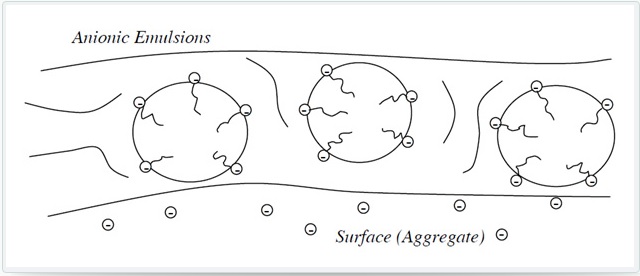
In an application of cationic emulsion, we are applying positively charged drops of bitumen to a negatively charged surface. The bitumen drops are immediately attracted to the surface and begin to break. The emulsion also loses water by evaporation. Thus the cationic emulsion has two breaking mechanisms at work and will break faster than a corresponding anionic emulsion. A depiction of the application is shown below:
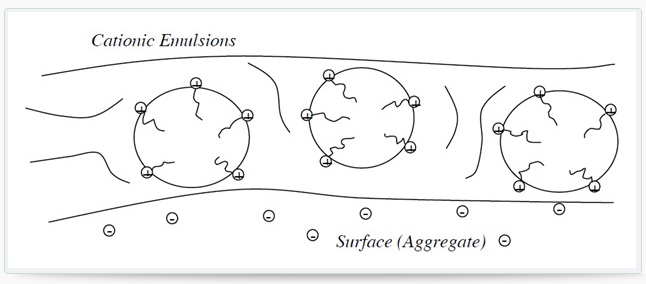
The object of a surface treatment is to seal the road from moisture intrusion and provide a new skid resistant surface, but be open to traffic as soon as possible and retain aggregate. Due to the chemistry of emulsions, they may react differently in specific weather and application conditions. If you have problems in any of these areas, the problem could be because of the weather, aggregate condition or emulsion used.
In bitumen emulsions, the basic bitumen has also been diluted in order to facilitate application. Hot bitumen, water, and emulsifier are processed in a high-speed colloid mill that disperses the bitumen in the water. The emulsifier produces a system in which fine droplets of bitumen, of between 30% and 80% of the volume, are held in suspension. If they separate in storage, the emulsion can easily be restored by agitation.
Bitumen emulsions have a low viscosity and can be workable at ambient temperatures, which makes them ideal for use in road pavements and surfacing. This application requires controlled breaking and setting. The emulsion must not break before they are laid on the road surface but, once in place, they should break quickly so that the road can be in service again without delay.
RABIT (RAHA BITUMEN) Co. as the leading supplier cutback and emulsion bitumen in the global market. For any inquiries, please contact our sales team on info@rahabitumen.com
The stability of emulsions is dependent on the following factors:
- Types of bitumen emulsifier and its quantity
- Water evaporation rate
- Bitumen quantity
- Bitumen globules size
- Mechanical forces
The emulsions are applied by using sprays. For this viscosity is a primary concern. With the increase of bitumen content, the mixture becomes more viscous. This is found to be sensitive when the amount exceeds 60%.
BASED ON SETTING TIME
WHEN BITUMEN EMULSIONS ARE APPLIED ON AGGREGATES, WATER STARTS TO EVAPORATE CAUSING SEPARATION OF BITUMEN FROM WATER. AND THEN BITUMEN SPREADS ON THE SURFACE OF THE AGGREGATE AND ACTS AS A BINDING MATERIAL AND SLOWLY ATTAINS ITS STRENGTH.
DEPENDING UPON THE SPEED AT WHICH WATER EVAPORATES AND BITUMEN PARTICLES SEPARATE FROM WATER, IT IS CLASSIFIED INTO FOLLOWING 3 TYPES.
- RAPID SETTING EMULSION (RS)
- MEDIUM SETTING EMULSION (MS)
- SLOW SETTING EMULSION (SS)
NOTE: HERE THE WORD “SETTING” SHOULD NOT MEAN ATTAINMENT OF STRENGTH; RATHER IT MEANS THE TIME TAKEN BY THE BITUMEN TO SEPARATE FROM WATER.
Typical Emulsion Designations
| Emulsion grade |
Cationic |
Anionic |
set |
Minimum asphalt content |
Notes |
| SS-1 |
|
* |
Slow |
57 |
|
| SS-1h |
|
* |
Slow |
57 |
|
| QS-1h |
|
* |
Slow |
57 |
Meet ASTM D3910 |
| CSS-1 |
* |
|
Slow |
57 |
|
| CSS-1h |
* |
|
Slow |
57 |
|
| CSS-1hP |
* |
|
Slow |
57 |
Whith 3% polymer |
| CQS-1h |
* |
|
Slow |
57 |
Meet ASTM D3910 |
| MS-1 |
|
* |
Medium |
55 |
|
| MS-2 |
|
* |
Medium |
65 |
|
| MS-2h |
|
* |
Medium |
65 |
|
| CMS-2 |
* |
|
Medium |
65 |
|
| CMS-2h |
* |
|
Medium |
65 |
|
| HFMS-1 |
|
* |
Medium |
55 |
High float |
| HFMS-2 |
|
* |
Medium |
65 |
High float |
| HFMS-2s |
|
* |
Medium |
65 |
Whith 1-7% solvent |
| HFMS-2h |
|
* |
Medium |
65 |
High float |
| RS-1 |
|
* |
Rapid |
55 |
|
| RS-2 |
|
* |
Rapid |
63 |
|
| CRS-1 |
* |
|
Rapid |
60 |
|
| CRS-2 |
* |
|
Rapid |
65 |
|
| CRS-2P |
* |
|
Rapid |
65 |
Whith 3% polymer |
| HFRS-2 |
|
* |
Rapid |
63 |
High float |
NOTE
h designates a harder emulsion residue penetration between 40 and 90 DMM at 25C
s designates a requirement that the emulsion also contains solvent or distillate.
CHEMISTRY OF BITUMEN EMULSIONS
What chemicals are present in the emulsion?
The main components of the emulsion are asphalt (bitumen) and water. Emulsions come in different grades but typically contain between 55 and 75% asphalt. In addition to the asphalt and water, asphalt emulsions contain 0.1-2% of an emulsifier or ‘soap’ which functions to stabilize the emulsion. These soaps are similar in nature to the soaps and detergents used in household cleaning and personal care. The asphalt emulsions may also contain minor amounts (< 1%) of other ingredients such as pH (acidity) regulators and viscosity regulators.
Tell me more about the emulsifying agents.
The most common products are fatty acids and lignins derived from wood, these form soap by reaction with sodium hydroxide. The soaps become negatively charged in water and give “Anionic” asphalt emulsions. Another class of emulsifiers, amines are derived from wood acids (tall oils) or animal fats (tallow). These emulsifiers form soaps, which become positively charged in water and give “cationic” asphalt emulsions.
How are bitumen emulsions made?
Hot asphalt is mixed with a water and soap (emulsifier) in a high-speed mixer called a colloid mill. The combination of the soap and high shear breaks the asphalt up into small droplets, which remain dispersed in the water.
How do they work?
When asphalt emulsion is mixed with the aggregates used in road construction, the emulsion is destabilized and the droplets of asphalt fuse together providing a strong adhesive bond to ‘glue’ the aggregates together. Water evaporates but the emulsifiers remain behind in the asphalt where they provide a valuable function in helping the asphalt stick to the aggregate.
HISTORY OF BITUMEN EMULSION
- First developed in the 1900’s
- In the 20’s asphalt emulsions came into general use for paving applications
- Early use was in spray applications and dust control.
- Interest picked up in the 50’s for farm to market roads
- The environmental movement in the 1970’s prompted the increase in emulsion manufacturing due to concerns about pollution from cutback asphalts (VOC’s)
- New formulations have increased performance for many applications
What is Bitumen Emulsion?
- Two liquids or components with one dispersed continuously through the other
- The immiscible materials are held together in a stable suspension with the aid of a surfactant
- Examples of common emulsions are shampoo, milk, mayonnaise, and paint
How Emulsifiers Work
Both cationic and anionic emulsifiers are surfactants (soaps)
- Gives stability to the emulsion
Does not allow the Oil (asphalt) to separate from the water
- Gives a charge
Cationic vs. Anionic (Positive vs. Negative)
- Imparts setting characteristics
Slow Set, Medium Set, and Rapid Set
Anionic Emulsifier Structure
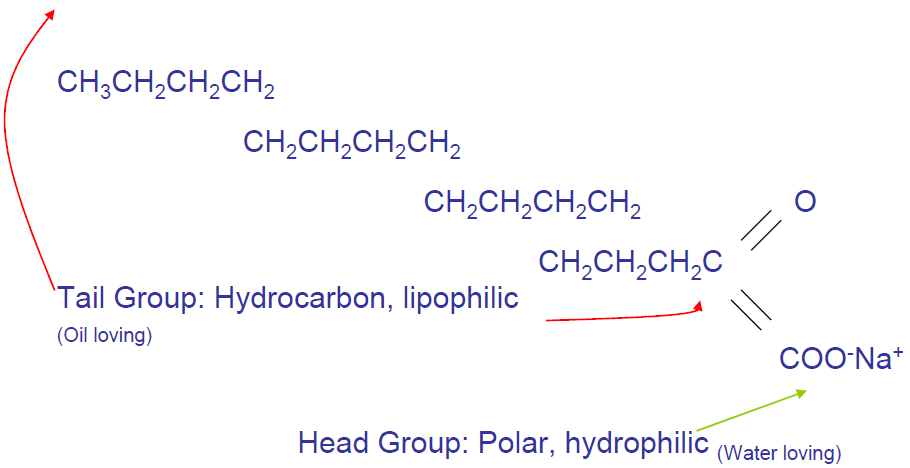
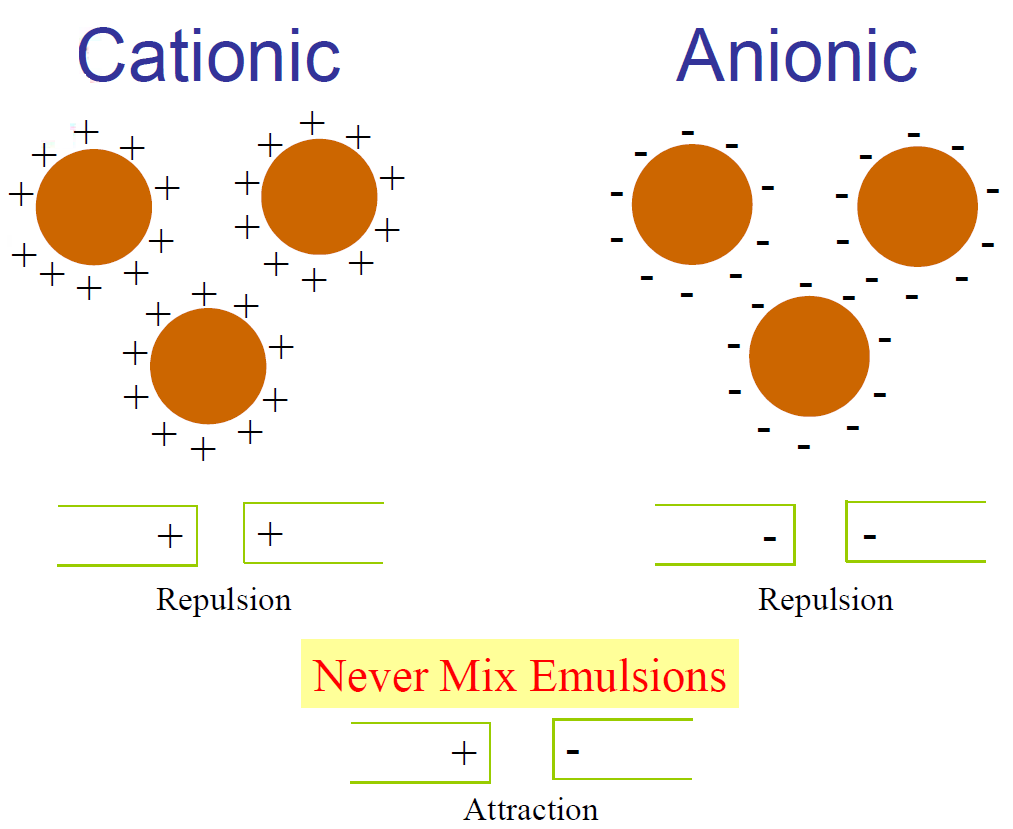
Chemical set

Naming The Emulsions
Prefix
- RS = rapid set
- SS = slow set
- QS = quick set
- MS = medium set
- HFRS = high float rapid set
- C = Cationic
- AE = anionic emulsion
Suffix
- 90,150, or 300 = penetration ranges
- h = hard penetration
- P,M or L = modified with polymer or latex
- 1 = low viscosity, stored @ cooler temps
- 2= high viscosity, stored @ higher temps
For example
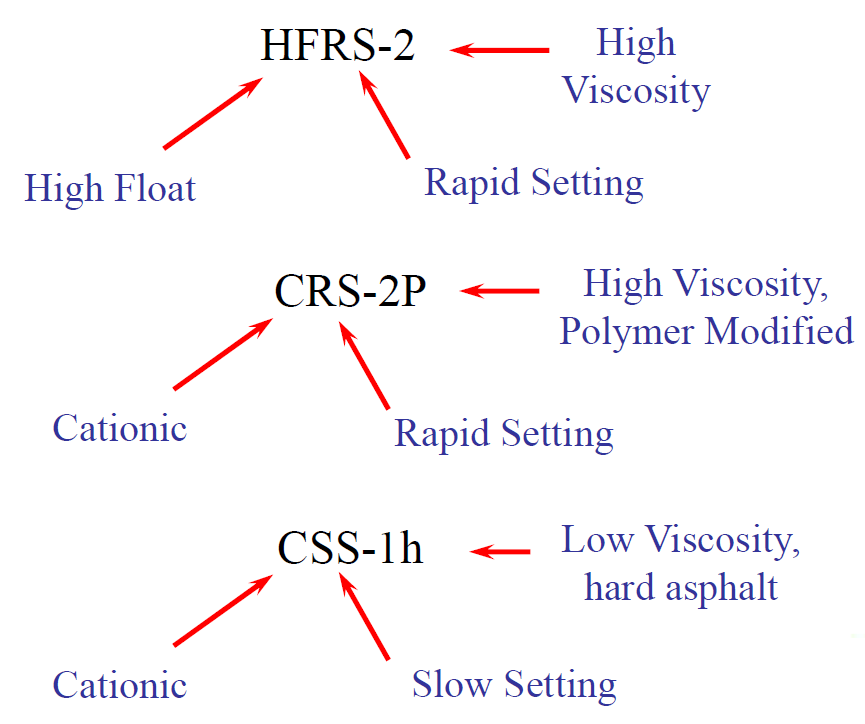
Modifications
- Polymers
-SBS & SBR
- Large Molecules
-Increase Service Life of the Project
- Early Chip Retention
- Flexibility
- Elasticity
GENERAL CLASSIFICATION
- Rapid-Setting
- Medium-Setting
- Slow-Setting
- Quick-Setting and Micro-Surfacing
- Designed to react quickly with aggregate and revert from the emulsion to the asphalt.
- Primarily used for spray applications.
-RS-2, HFRS-2, MWS-90, and CRS-2
MEDIUM SETTING EMULSION
- Designed for mixing with graded aggregate.
- Formulated not to break immediately upon contact with aggregate and will remain workable for a few minutes to several months depending upon the formulation.
- Primarily used in pugmills.
– MS-2, CMS-2, HFMS-2, MWS-150 & 300
SLOW-SETTING EMULSION
- Designed for mixing stability.
- Primarily used with high fine content aggregates, tack coats, fog seals and dust palliatives.
-SS-1h, Dusty, Dust Control
QUICK-SETTING & MICRO SURFACING
- Designed specifically for slurry and micro surfacing emulsions.
- Allows quicker opening to traffic times.
- Micro-surfacing emulsions are polymer modified and allow mixes to be placed at a greater thickness than slurry seals.
-CSS-1h, CQS-1h, and CQS-1hM
Advantages of using Bitumen Emulsion
- No need for the heating process when operating.
- No need for chemical solvents
- No risk of fire during storage, transportation, and implementation
- No risk of environmental contamination
- Bitumen emulsion applications produce no or minimal hydrocarbon emissions.
- Emulsification requires no petroleum solvents. (Some mixing grade emulsions may have small amounts of solvent to enhance mixing qualities.)
- Used at ambient temperatures, emulsions require no added heat for most applications and produce minimal fumes.
- Applicable in humid climates.
- Extensive application in road construction and maintenance.
- Another application of bitumen emulsion is stabilization of the shifting sands and mulching which are effective for the desert and western area of the country suffering the risk of exposure to dust.
- Emulsions are ideal for non-attainment areas where fume emissions are limited.
- Emulsions are ideal for remote locations where there are no hot mix plants.
- Bitumen emulsions readily coat damp aggregate surfaces, reducing the fuel required for drying aggregates.
- Pavement preservation applications greatly reduce needs for raw materials and energy for corrective maintenance and reconstruction.
- Preserved, smoother pavements reduce vehicle repair and fuel needs.
- The manufacturing and processing are handled by a team of highly skilled professionals from the industry who are dedicated towards producing high-quality bitumen Emulsion.
Due to kerosene content of cutback bitumen, they suffer from essential problems in utilization per the following:
– Consuming the kerosene as a valuable commodity
– Environmental contamination due to evaporation of the solvent into the air and penetration into the soil layers and underground watersheds.
– Risks of combustion and respiration of kerosene while operating.
Using water instead of for kerosene in bitumen emulsion, not only avoid the problems of cutback bitumen but also it causes an increase in the bitumen efficiency and adhesiveness; meanwhile, this type of bitumen has a higher quality and may be applied in lower temperatures.









